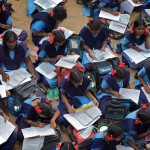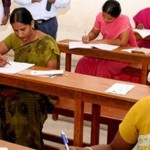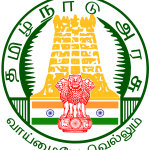
1. The Romans trading with South India during the Sangam age built the temple of Augustus at
A) Puhar B) Arikamedu
C) Muziris D) Uraiyur
Explanation : Ans : (C)
Trade had flourished between the Tamil country and Rome even when Rome was a republic. Roman coins and artefacts of the period have been excavated at Arikamedu, near Pondicherry.
Roman ships had begun to sail to ports on the coromandel (east) coast of Tamilnadu, many of these ports are mentioned in the Periplus. On the west coast, the main ports were Naura (Cannanore) and Tyndys / Tondi (Ponnani). Muziri was an important port located near Cochin (Kerala). A recently discovered trade agreement written on papyrus between a merchant of Muziri and a merchant of Alexandria indicates the large consignments of cargo carried even by individual merchants.
In Sangam age, temple for Augustus had been built at Muziri (near Cochin).
2. Which of the following part of the Constitution deals with the fundamental duties ?
A) IV A B) XIV A
C) IX A D) X A
Explanation : Ans : (A)
The original constitution contained only the fundamental rights not the fundamental duties.
The Fundamental Duties in the Indian Constitution are inspired by the constitution of erstwhile USSR.
In 1976, the congress party setup the
Sardar Swaran Singh Committee to make recommendations about fundamental duties.
The government accepted these recommendations and enacted the 42nd
constitutional Amendment Act in 1976. This amendment added a new part, namely,
Part IV A to the constitution. This new part consists of only one Article,
Article 51 A which for the first time specified a code of ten fundamental
duties of the citizens.
Fundamental duties are applicable only to the citizens of India not foreigners.
Fundamental duties cannot be enforced through writs.
In 2002, one more Fundamental Duty was added. “Responsibility of parents or guardians to provide opportunities for education to their children”.
3. As per National Sample Survey (NSS) 27th round in India ………. of the rural population has no skills at all.
A) 91% B) 70%
C) 84% D) 94%
Explanation : Ans : (A)
The National Sample Survey Office (NSSO), formerly called the National Sample Survey Organisation is the largest organisation in India conducting periodic socio-economic surveys. It is under the Ministry of Statistics.
Set up in 1950, the employees of the NSSO are from the Indian Statistical Service and the Subordinate Statistical Service. The NSSO conducts large-scale sample surveys throughout India.
The NSSO has Four Divisions :
Survey Design and Research Division
Field Operations Divisions
Data Processing Division
Co-ordination and Publication Division.
4. “Southerly trades on crossing the equator are deflected to the right” is proposed by the
A) Humbolt law B) Buy Ballot’s law
C) Ferrel’s law D) Newton’s law
Explanation : Ans : (C)
Ferrel’s law : All winds / objects are deflected to their right in the northern hemisphere and to their left in the southern hemisphere with respect to the rotation of the earth. This phenomenon is known as Ferrel’s law.
10. Which one of the following pair is not matched correctly ?
A) SANKALP – Ministry
of Skill
Development
B) STRIVE – Ministry of MSME
C) SAMPADA – Ministry
of Food
Processing
D) SAUBHAGYA – Ministry of Power
Explanation : Ans : (B)
SANKALP :
Skills Acquisition and Knowledge Awareness for Livelihood Promotion (SANKALP) is ` 4455 crore centrally sponsored scheme including ` 3300 crore loan support from World Bank to boost Skill India Mission. It is under the Ministry of Skill Development.
SANKALP envisages setting up of Trainers and Assessors academies with self sustainable models. Over 50 such academies are to be set up in priority sectors.
It also aims at enhancement of inclusion of under privileged and marginalized communities including women, Scheduled Castes / Scheduled Tribes and persons with Disabilities. It will also develop a skilling ecosystem that will support the country’s rise in Ease of Doing Business Index.
STRIVE :
Skill Strengthening for Industrial Value Enhancement (STRIVE) is ` 2200 crore central sector scheme with half funding will be World bank loan assistance.
STRIVE scheme will incentivize ITIs to improve overall performance including apprenticeship by involving SMEs (Small Scale Enterprises), business association and industry clusters.
It will develop robust mechanism for delivering quality skill development training by strengthening institutions – National Skill Development Corporation (NSDC), State Skill Development Missions (SSDHs), Sector Skill Councils, ITIs and National Skill Development Agency (NSDA) etc.,
It is also aligned to flagship Government programs such as Make in India and Swachhta Abhiyan.
SAMPADA :
The Cabinet Committee on Economic Affairs (CCEA) has approved renaming of SAMPADA (Scheme for Agro-Marine Processing and Development of Agro-Processing Clusters) as Pradhan Mantri Kisan Sampada Yojana (PMKSY).
It is launched by the Union Ministry of Food Processing for food processing sector. The schemes will integrate current and new schemes aimed at reducing food wastage and doubling farmer’s income by 2022.
SAUBHAGYA :
The centre had launched the Pradhan Mantri Sahaj Bijli Har Ghar Yojana, Saubhagya scheme to provide electricity to all households by December 2018. The households identified via the Socio-economic and Caste Census (SECC) of 2011 are provided with free electricity connections. The scheme aimed at providing last mile connectivity and electricity connections to all remaining households in rural as well as urban areas. This scheme is under the Ministry of Power.





